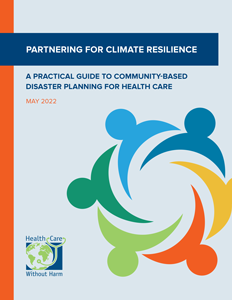Create an action plan to reduce your hospital or health care facility's GHG emissions by identifying and prioritizing possible interventions. Identify interventions by scope, activity, or category and estimate the costs and savings of each intervention in terms of dollars, the return on investment (ROI), or reduction in metric tons of carbon-dioxide-equivalent (MTCO2e), an industry standard measure. The plan also includes space to recognize potential challenges that may arise during intervention implementation to allow for a comprehensive and transparent process.
 This guide provides actionable steps and sample materials to assist health systems and community organizations in conducting an exercise aimed at identifying vulnerabilities and inequities and preparing for climate impacts.
This guide provides actionable steps and sample materials to assist health systems and community organizations in conducting an exercise aimed at identifying vulnerabilities and inequities and preparing for climate impacts.
Join Practice Greenhealth
Practice Greenhealth is the health care sector’s go-to source for information, tools, data, resources, and expert technical support on sustainability initiatives that help hospitals and health systems meet their health, financial, and community goals.
